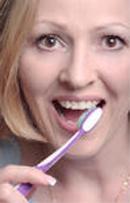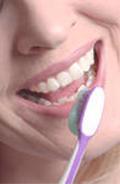
Teeth as sparkle your smile The visible part of a tooth, otherwise known as the crown, is only a small portion of the living system. The crown is made up of enamel, the hardest substance found within the body. It is bone that has been enriched with large percentages of calcium. That's why people who drink lots of milk or take calcium supplements have strong bones and teeth. The enamel is thickest at the crown, and thinnest near the roots of the teeth. Excellent crowns and bridges were made by the Etruscans in the 7th cent. B.C. At about that time, teeth were being extracted in Asia Minor as a cure for bodily ills and diseases. Skills achieved by the Etruscans, Phoenicians, Egyptians, Greeks, and Romans were largely lost during the Middle Ages, when barbers and roving bands of charlatans practiced unskilled dentistry at marketplaces and fairs. Abulcasis, a Spanish Moor, was one of the few in his time who studied dental surgery. The permanent teeth are the second set of teeth that will last the rest of your life. They tend to be more yellow (and not just because of coffee) and are extremely hard. The final set of teeth is made up of 32 teeth, or 16 on each jaw. There are two central incisors for biting, two lateral incisors for biting, two canines for tearing and cutting, four premolars for chewing, and six molars for chewing.
What are dental dentures? Dentures are removable replacements for missing teeth typically made out of an acrylic resin which at times incorporate porcelain or metal for additional structural support. There are two main types of dentures. Both Complete Dentures and Partial Dentures are finely crafted, custom-fitted. If you properly maintain your dentures they will appear natural and provide a perfect smile. Additionally, dentures help strengthen muscles controlling your expressions that require the support of your teeth, rid you of pronunciation problems caused by missing teeth and aid with chewing. If you've lost, or are losing, all of your teeth a Complete Denture is something to discuss with your cosmetic dentist. If some of your teeth remain and are healthy, a partial denture may be your way to a great smile.
Tooth crowns Grinding your teeth, an improper bite, age, fillings and tooth decay can all be contributing factors in the wearing down, cracking or breakage of your teeth. Dental crowns cover the entire visible surface of your affected tooth and add strength, durability and tooth stability. In other instances, crowns are used to replace a actual missing tooth. These crowns are anchored to the teeth on either side, with a bridge section connecting the two crowns. Instead of bridges, single tooth dental implants may be used that eliminate the need for supporting the crowns. In some cases your cosmetic dentist may choose to use a Flipper instead of a temporary crown. A Flipper is a false tooth to temporarily take the place of a missing tooth before the permanent crown is placed. A Flipper can be attached via either a wire or a plastic piece that fits in the roof of your mouth. Flippers are meant to be a temporary solution while awaiting the permanent crown.
Teeth straightening Teeth straightening is accomplished with a number of different procedures and is usually done on children and adolescents when their permanent teeth begin growing in. Crooked teeth, crowded teeth, and even overbites and underbites can be treated with various teeth straightening techniques. While considered a cosmetic procedure, some people require teeth straightening in order for their teeth to be aligned in such a way that chewing is possible. Severe overbites and underbites can result in serious consequences over time, and even overly crowded teeth can mean health problems for the mouth. The classic metal orthodontic braces are the most familiar method of teeth straightening. Consisting of a bracket glued to the front of each tooth and a metal wire connecting them, orthodontic braces usually require several years of wear for effective teeth straightening. They can be uncomfortable, expensive, and embarrassing for older patients. However, they are still the most effective method of teeth straightening and can correct overbites and underbites as well as individual teeth alignment. Some tenderness and soreness is to be expected with any method of teeth straightening, especially soon after an adjustment is made. The bone on one side of each tooth socket will be compressed, and the other side must be filled in with new bone as the tooth moves through the jaw. Standard orthodontic braces may cause superficial irritation to the interior of the mouth, a symptom that can be reduced with salt water gargles and a soft wax on the surface of the brackets. Severe side effects to teeth straightening are nearly unheard of, and the process is considered very safe.

Terms and definitionsDental fillings
- Dental fillings are inserted as restorations in the treatment of dental cavities, after drilling out the cavities.
Dental implants
- Dental implants are surgically fixed substitutes for roots of missing teeth. Embedded in the jawbone, they act as anchors for a replacement tooth, also known as a crown, or a full set of replacement teeth.
Dentures
- Removable complete dentures are full-mouth false teeth, which are used when a patient has no teeth left on either the mandibular arch, the maxillary arch, or both.
Veneer
- A layer of tooth-colored material, usually porcelain or acrylic resin, attached to and covering the surface of a metal crown or natural tooth structure.
Anesthesia
- Total or partial loss of sensation, especially tactile sensibility, induced by disease, injury, acupuncture, or an anesthetic, such as chloroform or nitrous oxide.
- Local or general insensibility to pain with or without the loss of consciousness, induced by an anesthetic.
- A drug, administered for medical or surgical purposes, that induces partial or total loss of sensation and may be topical, local, regional, or general, depending on the method of administration and area of the body affected.
Bridge
- A dental bridge is a prosthesis used in place of missing teeth and may be removable or permanently attached.
Dental cavities
- The formation of cavities in the teeth by the action of bacteria; tooth decay.
- Also known colloquially as tooth decay.
Dental crown
- Full-coverage restoration (sometimes incorrectly called a cap) is a prosthetic tooth designed by a dentist and usually created by a lab technician.
Porcelain
- A hard, white, translucent ceramic made by firing a pure clay and then glazing it with variously colored fusible materials.
Stomatology
- The medical study of the mouth and its diseases.
Tooth bleaching
- Also known as tooth whitening.
|